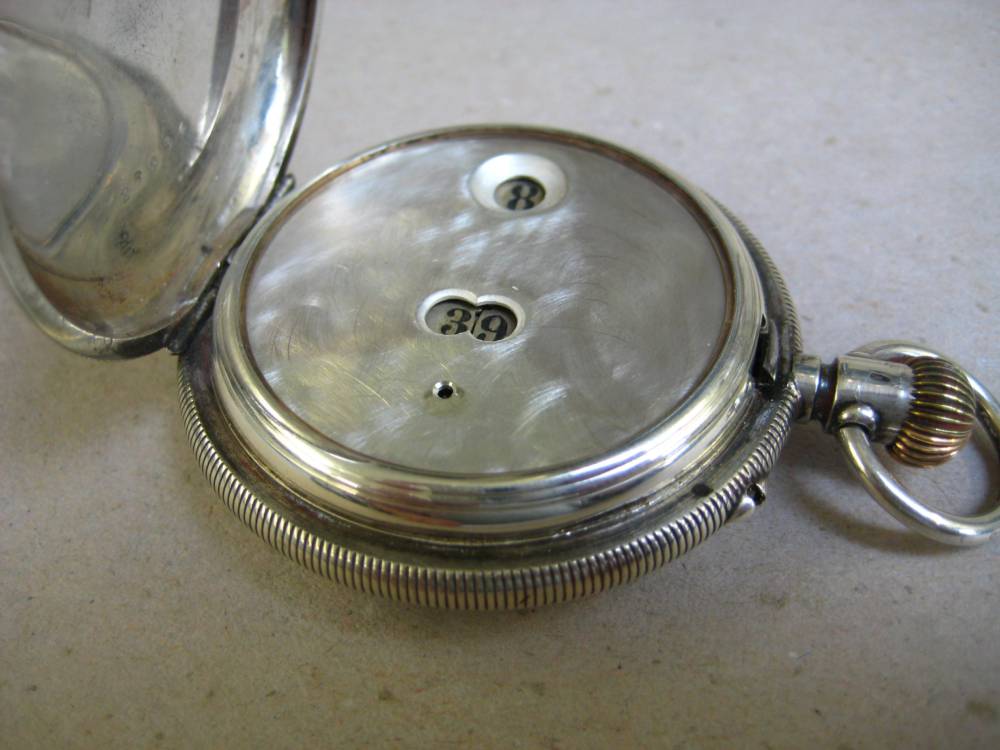I love these Pallweber enamel dials with their floral arrangements.
Today, to compliment Tonny's post on the Pallweber and to bring something
different, I share the tale of two Pallweber Projects here in my Collection.
The Project that Stopped
I have one particular watch in the collection with a similar dial, which
looked like this (below) when I aquired it. The watch was also in running
condition.

As Tonny writes, not all the Pallwebers had the International Watch Co. logo
on the dial, and despite the fact that as can be seen in the photo above, that
the bezel which holds the glass over the dial was missing, it had the script
logo, which I really like, I also found the watch to be to pretty to let pass
by, and decided to secure and it and make a restoration project of it.
I engaged my case maker, and as you see in the picture here below, a
replacement bezel in 0.925 Sterling silver was manufactured.
For my case maker this was a simple excercise of measuring up and making an
exact duplicate of an existing bezel of mine from another pallweber in the
same case. (more on these cases lower down). I say simple, as he makes it look
simple. My watchmaker on the other hand, could not tell the difference between
old and new, and when one looks at the complexity of these cases and the
precise sizing needed in order for that bezel to "snap"on to the case itself,
then one realises the skill of the craftsmen who made (and make) these cases.
The dial you see in the case is a tempoary one so as not to risk the enamle
dial when working on the case.

Once we had reached this stage, the watch was sent off to those Wizzards of
Schaffhausen to do a full SPA restoration of movement and the dial too, was to
have that single hairline crack in it, fixed.
Typically, Schaffhausen are rather quick to return with a cost proposal.
However, now a week went by with no responce, and then a second week followed
without responce. I started to get nervous.
Then the email came. It was not to be. After much discussion in Schaffhusen,
someone somewhere had reached the conclusion that this beautiful floral dial
WAS NOT AN ORIGINAL IWC DIAL.
The project was stopped - and remains parked until such time that more can be
discovered and or becomes known about what constitutes and original IWC
Pallweber Dial.
The Project that went Through
Not long after the disappointment above at needing to park that Pallweber
restoration project, I came accross another Pallweber for sale.
However, this one was to say the least, in need of lots of TLC. It was in
what appeared to be a realy sorry state.

For a start, the case had been through the wars. Other than a number of
serious dents, it also seemed that somewhere along the line the bow which sits
around the crown of the watch, had been violently broken off as you see in
this picture above.
The damage was to both sides of the Crown Neck.

And to add insult to injury, the dial of this watch was in no way as near as
pretty as the one above !

A project not for the frail of heart.
However, when we took this one to Schaffuasen with the question of "should we
try save this watch" the answer was very different than the stopped project
above. An examination of the records tells us, that this watch was one of an
order of 10 Pallwebers sold to Weil and Harburg of London on the 16th January
1886.
In addition, the case serial number, movement serial number and description of
the dial on the watch match the records in the archives.
Game On !
The first thing we tackled was that crown neck. Here is the result of the
repair.

I believe that we can all agree that this was an amazing bit of silversmithing
by my Case Maker.
The real interesting thing (and there is a story here - but thats for another
post) is that unlike most other IWC silver cases from Schaffhausen, this case
is not 0.800 or 0.900 German Silver, neither 0.925 Sterling.

But rather 0.935 Sterling. This proved to be some challenge - as we could not
buy new silver bar in this composition. Such is the tenacity of the
restoration team, to ensure we stay true to the case (pun), we finally decided
to secure and melt down another swiss (non IWC) pocket watch case made of
0.935 silver, to obtain the metal for the new crown. However, at the last
minute, my local jewler came to the rescue, and smelted us up a mix that gave
us 0.935 Silver.
Watch this space as we move into the next phase of the restortion.















